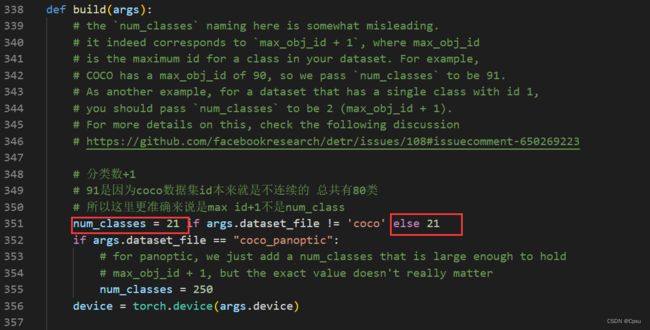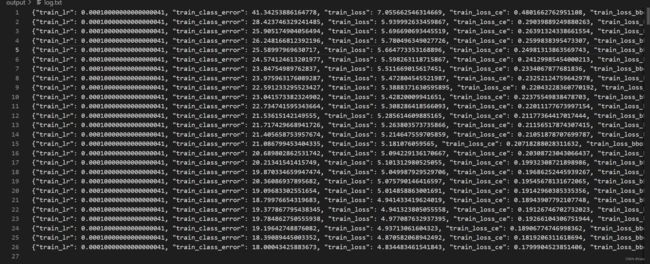【DETR】DETR训练VOC数据集/自定义数据集
训练DETR
- 一、数据准备
- 二、配置DETR
- References
一、数据准备
DETR用的是COCO格式的数据集。
如果要用DETR训练自己的数据集,直接利用Labelimg标注成COCO格式。
如果是VOC数据集的话,要做一个格式转换。网上一大堆格式转换的代码都很乱,所以自己写了一个针对VOC数据集的转换。
COCO数据集的格式类似这样,annotations文件夹里面有对应的train、val数据集的json文件。train2017则是训练集图片,其他同理。

VOC数据集的存放方式是这样的,转换格式就是找出Main文件夹下用于目标检测的图片。

Main文件夹下有train.txt文件,记录了训练集的图片。val.txt记录了验证集的图片

只需要修改注释中的两个路径即可(创建文件夹时没有加判断语句严谨一点应该加上)。
import os
import shutil
import sys
import json
import glob
import xml.etree.ElementTree as ET
START_BOUNDING_BOX_ID = 1
# PRE_DEFINE_CATEGORIES = None
# If necessary, pre-define category and its id
PRE_DEFINE_CATEGORIES = {"aeroplane": 1, "bicycle": 2, "bird": 3, "boat": 4,
"bottle": 5, "bus": 6, "car": 7, "cat": 8, "chair": 9,
"cow": 10, "diningtable": 11, "dog": 12, "horse": 13,
"motorbike": 14, "person": 15, "pottedplant": 16,
"sheep": 17, "sofa": 18, "train": 19, "tvmonitor": 20}
def get(root, name):
vars = root.findall(name)
return vars
def get_and_check(root, name, length):
vars = root.findall(name)
if len(vars) == 0:
raise ValueError("Can not find %s in %s." % (name, root.tag))
if length > 0 and len(vars) != length:
raise ValueError(
"The size of %s is supposed to be %d, but is %d."
% (name, length, len(vars))
)
if length == 1:
vars = vars[0]
return vars
def get_filename_as_int(filename):
try:
filename = filename.replace("\\", "/")
filename = os.path.splitext(os.path.basename(filename))[0]
return int(filename)
except:
raise ValueError(
"Filename %s is supposed to be an integer." % (filename))
def get_categories(xml_files):
"""Generate category name to id mapping from a list of xml files.
Arguments:
xml_files {list} -- A list of xml file paths.
Returns:
dict -- category name to id mapping.
"""
classes_names = []
for xml_file in xml_files:
tree = ET.parse(xml_file)
root = tree.getroot()
for member in root.findall("object"):
classes_names.append(member[0].text)
classes_names = list(set(classes_names))
classes_names.sort()
return {name: i for i, name in enumerate(classes_names)}
def convert(xml_files, json_file):
json_dict = {"images": [], "type": "instances",
"annotations": [], "categories": []}
if PRE_DEFINE_CATEGORIES is not None:
categories = PRE_DEFINE_CATEGORIES
else:
categories = get_categories(xml_files)
bnd_id = START_BOUNDING_BOX_ID
for xml_file in xml_files:
tree = ET.parse(xml_file)
root = tree.getroot()
path = get(root, "path")
if len(path) == 1:
filename = os.path.basename(path[0].text)
elif len(path) == 0:
filename = get_and_check(root, "filename", 1).text
else:
raise ValueError("%d paths found in %s" % (len(path), xml_file))
# The filename must be a number
image_id = get_filename_as_int(filename)
size = get_and_check(root, "size", 1)
width = int(get_and_check(size, "width", 1).text)
height = int(get_and_check(size, "height", 1).text)
image = {
"file_name": filename,
"height": height,
"width": width,
"id": image_id,
}
json_dict["images"].append(image)
# Currently we do not support segmentation.
# segmented = get_and_check(root, 'segmented', 1).text
# assert segmented == '0'
for obj in get(root, "object"):
category = get_and_check(obj, "name", 1).text
if category not in categories:
new_id = len(categories)
categories[category] = new_id
category_id = categories[category]
bndbox = get_and_check(obj, "bndbox", 1)
xmin = int(get_and_check(bndbox, "xmin", 1).text) - 1
ymin = int(get_and_check(bndbox, "ymin", 1).text) - 1
xmax = int(get_and_check(bndbox, "xmax", 1).text)
ymax = int(get_and_check(bndbox, "ymax", 1).text)
assert xmax > xmin
assert ymax > ymin
o_width = abs(xmax - xmin)
o_height = abs(ymax - ymin)
ann = {
"area": o_width * o_height,
"iscrowd": 0,
"image_id": image_id,
"bbox": [xmin, ymin, o_width, o_height],
"category_id": category_id,
"id": bnd_id,
"ignore": 0,
"segmentation": [],
}
json_dict["annotations"].append(ann)
bnd_id = bnd_id + 1
for cate, cid in categories.items():
cat = {"supercategory": "none", "id": cid, "name": cate}
json_dict["categories"].append(cat)
os.makedirs(os.path.dirname(json_file), exist_ok=True)
json_fp = open(json_file, "w")
json_str = json.dumps(json_dict)
json_fp.write(json_str)
json_fp.close()
if __name__ == "__main__":
# 只需修改以下两个路径
# VOC数据集根目录
voc_path = "VOC2012"
# 保存coco格式数据集根目录
save_coco_path = "VOC2COCO"
# VOC只分了训练集和验证集即train.txt和val.txt
data_type_list = ["train", "val"]
for data_type in data_type_list:
os.makedirs(os.path.join(save_coco_path, data_type+"2017"))
os.makedirs(os.path.join(save_coco_path, data_type+"_xml"))
with open(os.path.join(voc_path, "ImageSets\Main", data_type+".txt"), "r") as f:
txt_ls = f.readlines()
txt_ls = [i.strip() for i in txt_ls]
for i in os.listdir(os.path.join(voc_path, "JPEGImages")):
if os.path.splitext(i)[0] in txt_ls:
shutil.copy(os.path.join(voc_path, "JPEGImages", i),
os.path.join(save_coco_path, data_type+"2017", i))
shutil.copy(os.path.join(voc_path, "Annotations", i[:-4]+".xml"), os.path.join(
save_coco_path, data_type+"_xml", i[:-4]+".xml"))
xml_path = os.path.join(save_coco_path, data_type+"_xml")
xml_files = glob.glob(os.path.join(xml_path, "*.xml"))
convert(xml_files, os.path.join(save_coco_path,
"annotations", "instances_"+data_type+"2017.json"))
shutil.rmtree(xml_path)
二、配置DETR
修改main.py文件中的参数、超参数:

这个最好不改,就设为coco。去修改models/detr.py 文件的num_classes(大概在三百多行)。这里作者也解释了num_classes其实并不是类别数,因为coco只有80类,因为coco的id是不连续的,coco数据集最大的ID是90,所以原论文时写的MAX ID +1 即91。对于我们自定义的和转化的VOC数据集num_classes就是类别数。

![]()
coco_path改成自己的coco路径。

其中预训练权重需要修改一下,coco是80类,不能直接加载官方的模型。voc是20类。把num_classes改成21。传入得到的detr_r50_21.pth新的权重文件。
import torch
pretrained_weights=torch.load('detr-r50-e632da11.pth')
num_classes=21
pretrained_weights["model"]["class_embed.weight"].resize_(num_classes+1,256)
pretrained_weights["model"]["class_embed.bias"].resize_(num_classes+1)
torch.save(pretrained_weights,"detr_r50_%d.path"%num_classes)
References
VOC2COCO代码参考Github
DETR预训练模型

